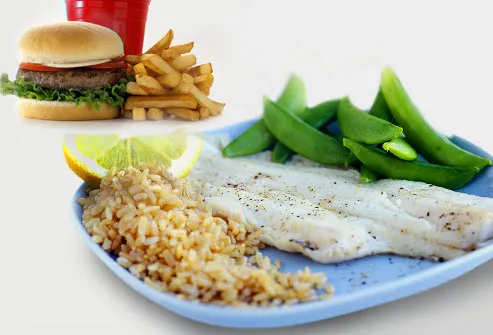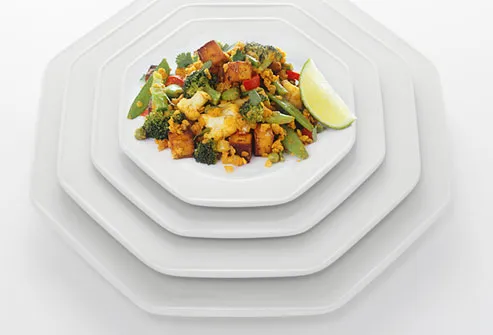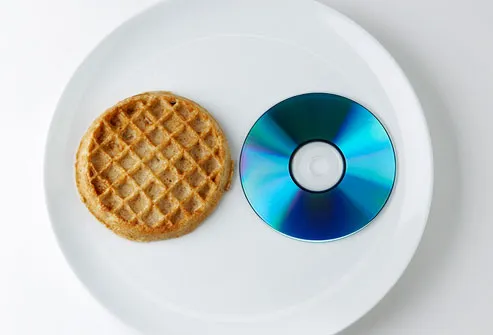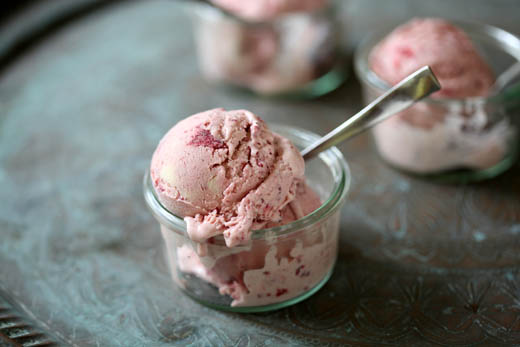A New American Diet
Our eating habits need help. Fast food, high-calorie desserts, sweet drinks, and more have filled us up -- and out. Most adults and 1 in 3 children in the U.S. are overweight or obese.
Changing the way you eat can be easy. To start, learn about some of the worst food offenders and how to replace them with healthier choices. Then try some portion-control tricks.
Calorie-Bomb Food Favorites
Most of our calories come from foods high in fat and sugar. Sweets like cookies and cakes, along with yeast breads, top the list. We also load up on calories in chicken dishes (often breaded and fried), sodas, and energy and sports drinks. Pizza, alcohol, pasta, tortilla dishes, and beef dishes pile on more calories. Unless you count fries and chips, fruits and vegetables don't even make a dent in our daily calorie count.
Eat Less
Just two problem foods -- solid fats and added sugars -- count for about 800 of our daily calories. That's almost half the calories an average woman should have in a day. U.S. dietary guidelines say we should limit solid, trans, and saturated fats. Cut back on fast foods and refined grains, like white bread. While you're at it, cut down on sodium (salt), too. Most of us get too much, raising our chances of high blood pressure and heart and kidney disease.
Eat More
Add more nutritious foods to your diet.
- Instead of fatty meats, choose lean protein and seafood. Shoot for at least 8 ounces of fish a week.
- Instead of solid fats like butter or margarine, use olive, canola, and other oils that are good for your waistline and heart.
- Instead of baked goods and cereals with all white or refined grains, make at least half of your grains whole grains.
- Other healthy choices: nonfat or low-fat dairy foods, eggs, beans, and lots of fruits and vegetables.
The Pizza Problem
Favorite foods like pizza may just need a makeover. Pizza can have lots of calories, refined grains, and fats. But with a few tweaks, it can be OK:
- Choose a thin, whole-grain crust.
- Pile on veggies and skip meat.
- Use low-fat or fat-free cheese or just a sprinkle.
- Have one small slice and fill the rest of your plate with vegetables.
What Are Whole Grains?
The outer shell, or "bran," of a kernel of wheat, rice, barley, or other grain is full of fiber, vitamins, and minerals. Fiber helps you feel full on fewer calories and keeps your bathroom visits regular. But to make white (refined) flour from a kernel of wheat, food makers get rid of the bran. With it goes much of the fiber and vitamins.
What Are Solid Fats?
Fats that are solid at room temperature usually contain saturated and trans fats. Trans fats should be avoided as much as possible and saturated fats should only contribute 10% of your calories. You will find saturated fats in butter, coconut oil, animal fats in meat, dairy, bacon and chicken skin.
Serving the Right Size
Start downsizing to healthy portions and your body will, too. Check food labels and restaurant menus for hidden calories. Learn to "eyeball" your food to gauge what’s too much -- and what’s just right.
Shrink Your Plate to Lose Weight
You may have grown up being told to "clean your plate." The problem is that dinner plates in homes -- and restaurants – have gotten bigger. And so has the amount of food we put on them. If you clean your plate now, you're probably overeating.
Set Out Salad Plates
To shrink your portions:
- Eat from a smaller dish like a luncheon or salad plate.
- Learn and serve the right-sized portion.
- Don't go back for seconds or keep extra food on the table to tempt you.
- Store leftovers in single-serving containers for quick meals.
Eating Out? 4 Tips on Portion Size
Restaurants usually serve one person enough food for two or three. But you don't have to eat it all.
- Order a half portion or something from the kid's menu.
- If you order a full-size entree, box up half of it before you start eating.
- Split a dish with a friend.
- Eat a healthy appetizer and soup or salad instead of an entrée.
Your Daily Diet
How many calories you should have depends on your age, your gender, and how active you are. An inactive woman should have 1,600-1,800 calories a day. An active average-sized man should have 2,400-2,800 calories. Have a healthy balance of foods each day:
- 1 1/2 - 2 cups of fruit and 2 1/2 - 3 1/2 cups of vegetables
- 5-8 ounces of grain, 1/2 from whole grains
- 3 cups of nonfat or low-fat dairy foods
- 5-6 1/2 ounces of protein (meat, beans, and seafood) each day
- No more than 5-7 teaspoons of oils, mostly from plants, fish, and nuts
- 121 calories from solid fats and added sugars
Learn to Eyeball a Portion Size
You don't need to weigh or measure your food every time you eat. Instead, keep a mental image of a deck of cards, a poker chip, a baseball, a hockey puck, a CD, dice, and a light bulb. This makes it easy for you imagine healthy portion sizes.
Cut That Baked Potato Down to Size
1 medium potato = 1 computer mouse
That's equal to 1 cup of vegetables.
If you use a mouse every day, it's easy to grab the right size of potato at a grocery store. But a restaurant potato is likely to be twice that big and loaded with toppings and extra calories. To eat smart when you eat out:
- Eat part of the potato and take the rest home for another meal.
- Choose a sweet potato instead. It gives you vitamin C and vitamin A, which keep your eyes and skin healthy.
A Healthy Portion of Pasta
1 portion of pasta is 1/2 cup = 1/2 a baseball
That's 1 ounce, or 1/2 cup, of grains.
That's 1 ounce, or 1/2 cup, of grains.
For healthier pasta:
- If you eat more than one portion of pasta when you eat out, skip the breadbasket. But count the extra pasta as another portion of grains for the day.
- Try whole-grain pasta. You'll fill up on less and get extra fiber.
- Instead of Alfredo or other creamy sauces, choose tomato-based marinara.
- Use low-fat salad dressing when you make pasta salad.
Trim Waffles Down to Size
1 portion of pancake or waffle = the size of a CD
That's a 1-ounce serving of grains.
That's a 1-ounce serving of grains.
Skip plate-sized waffles and stacks of pancakes swimming in syrup and butter. Instead:
- Order a small pancake and an egg. That's a serving each of grains and protein.
- Order whole grains, like a buckwheat or whole wheat pancake. You get more fiber and nutrition and stay full longer.
- Opt for fresh fruit or sugar-free syrup as a topping.
Your Favorites Can Fool You
Bagels and bran muffins seem like healthy eating choices. But they can be two or three times too big. A large bagel and even a low-fat muffin can pile on 300 calories. Spread it with butter or cream cheese, and you've added more fat and calories. Breakfast can be a whopping 500 calories.
Size Is Everything at the Bakery
1 small muffin = a tennis ball
1/2 a medium bagel = a hockey puck
That's a 1-ounce serving of grains.
1/2 a medium bagel = a hockey puck
That's a 1-ounce serving of grains.
Don't overdo it with bagels and bran muffins:
- To save calories, eat a high-fiber English muffin instead.
- Eat half of a large one or buy smaller sizes.
- Make the bagel whole grain. The high fiber will curb hunger later.
Watch Your Dairy Servings
1 portion of cheese = four dice
That's a 1-cup serving of dairy.
That's a 1-cup serving of dairy.
Cheese is high in calcium. Regular cheese is also high in fat. One serving of low-fat cheese is one-third the amount of nonfat or low-fat dairy you should have in a day.
- Try low-fat cheeses. They have gotten tastier.
- Watch your portions. Nibble cheese like a mouse.
- Ask for less cheese or low-fat cheese on pizza.
How Much Meat Is Too Much?
1 portion of meat or fish = a deck of cards or the palm of your hand
That's 3 ounces of protein.
Eat lean protein -- fish, poultry, eggs, nuts, and beans -- at every meal to help build muscle and lose weight. But you may need less protein than you think. Adults only need 5 to 6 1/2 ounces of protein a day. That could be one egg at breakfast, a handful of nuts (12 almonds or 24 pistachios) mid-day, and 3 ounces of meat for dinner.
Baseball-Sized Broccoli and Berries
1 serving of fruits or veggies = 1 baseball or a fist
1 serving of leafy greens = 2 tennis balls
That's a 1-cup serving of fruits or vegetables.
When it comes to fruits and vegetables, eat as much as you want.
- Green, red, and orange foods have lots of nutrition. That includes berries, red bell peppers, tomatoes, pumpkin, and sweet potatoes.
- Dark greens are heart healthy. Try spinach, broccoli, Swiss chard, and kale.
Go a Little Nuts for Peanut Butter
1 portion of peanut butter = a golf ball
That's 2 tablespoons or two 1-ounce servings of protein.
That's 2 tablespoons or two 1-ounce servings of protein.
Peanut butter and jelly is great comfort food. And snacking on peanuts and peanut butter can curb hunger. The trick is to make a little bit go a long way. Peanuts have healthy fat, but it's still fat and can add calories -- 190 for 2 ounces. Jelly adds more.
Rice Lightens Up a Healthy Meal
2 portions of cooked rice = a light bulb
That's 2 servings of grains.
That's 2 servings of grains.
Rice is low in fat and calories. Serve it with a rainbow of healthy vegetables -- like red peppers, bok choy, onion, and carrots -- stir-fried in a little peanut or canola oil.
- Steam rice instead of frying it to keep calories down.
- Try brown rice, which has more fiber than white rice.
- Don't ruin the health benefits of rice by topping it with fried food or heavy sauce.
It's Easy to Overdo Fats and Oils
1 portion of fat = a poker chip or a stack of four dimes.
That's 1 teaspoon, or 1 serving, of fats and oils.
That's 1 teaspoon, or 1 serving, of fats and oils.
You probably get enough fat in foods like cooking oil, salad dressings, meats, and nuts.
- Spray cooking oil in a pan before frying, instead of pouring in liquid oil.
- Use heart-healthy olive or canola oil instead of butter.
- Dress your salad with light vinaigrette instead of thick, creamy salad dressing.
A Handful of Chips
1 ounce = 6 large tortilla chips or 20 potato chips
That's 2 teaspoons of oil and 150 calories
That's 2 teaspoons of oil and 150 calories
Chips tend to be packed with the things we need to limit: unhealthy fat, refined grains, and sodium. Just one ounce can have nearly half of an entire day's fat for a woman.
Read the label: Baked, multigrain, and vegetable chips -- like carrot and sweet potato -- have more nutrients and may have less fat.
Keeping Dessert in Proportion
1 serving = 1/2 baseball
That's 4 ounces or 1/2 cup.
That's 4 ounces or 1/2 cup.
Desserts can be full of unhealthy fats and sugar. One cup of ice cream -- twice the size of a portion -- can have 285 calories and 75% of the solid fat an inactive woman should have in a day
- Save sugar calories for something to eat instead of a coffee drink or soda
- Instead of a bunch of cookies, have a small cookie and a piece of fruit or glass of milk.
- When you really want chocolate, eat dark chocolate, which has less sugar.
Source
http://www.webmd.com/diet/ss/slideshow-serving-sizes
Reviewed by Kathleen M. Zelman, MPH, RD, LD on /2, 15 1
This tool does not provide medical advice. See additional information
© 2015 WebMD, LLC. All rights reserved.







No comments:
Post a Comment